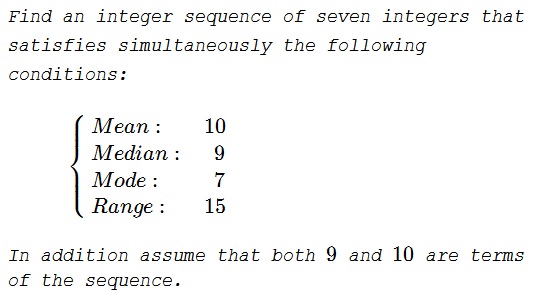Integer Sequence with Given Statistical Parameters
Problem

Solution 1
One solution I found is
$4,7,7,9,10,14,19$
Solution 2
Gökhan Karahan found this:
$5,7,7,9,10,12,20.$
Solution 3
Bryan Johnson came up with
$3,7,7,9,12,14,18.$
Solution 4
Amit Itagi gave a complete analysis:
Let the sequence sorted from smallest to largest values be labelled $a_i,~i\in\{1,2,...,7\}$. From the median, $a_4=9$, and one of $a_5,a_6,a_7$ is $10$. From the mode, either two or three of $a_1,a_2,a_3$ are $7$.
Suppose all three are $7$, then from the range, $a_7=7+15=22$. From the mean, the last undetermined number is $70-3\times 7-9-10-22=8$. This is not possible as the undetermined number has to be greater than $a_4=9$.
Suppose, there are two $7's$ in the sequence. First, suppose that $7$ is the smallest number. Thus, $a_3=8$ or $a_3=9$. From the range, $a_7=7+15=22$. Then, from the mean, the remaining two undetermined numbers ($a_3$ and another one) have to add up to $70-2\times 7-9-10-22=15$. Thus, the last number is either $15-8=7$ or $15-9=6$. Neither is greater than $a_4=9$. Thus, this case is not possible.
The remaining case is that there are two $7's$ and the $a_1\lt 7$. From the range, $a_7=a_1+15$. Thus, from the mean, $a_1$, $a_7$ and the other undetermined number (denoted by $b$) add up to $70-2\times 7-9-10=37$. Thus, $b+2a_1+15=37$ or $b+2a_1=22$. Note $b\leq a_7=a_1+15$. Thus, $22=b+2a_1\leq3a_1+15$ or $a_1>2$. Noting that $a_1\lt 7$, the possible combinations of $(a_1,b)$ are $(3,16)$, $(4,14)$, $(5,12)$, and $(6,10)$. The last combination is disallowed as $7$ is the mode. Thus, the possible sequences are: $(3,7,7,9,10,16,18)$, $(4,7,7,9,10,14,19)$, and $(5,7,7,9,10,12,20)$.
Solution 5
This is by N. N. Taleb:
Let $X=\left\{x_{(1)},x_{(2)},x_{(3)},x_{(4)},x_{(5)},x_{(6)},x_{(7)}\right\}$ ordered such that $x_{(1)} \leq x_{(2)} \ldots \leq x_{(7)}$.
We have $x_{(7)}=x_{(1)}+15$, $x_{(4)}=9$, and we need to solve for:
$\displaystyle \frac{1}{7} \left(2 x_{(1)}+x_{(2)}+x_{(3)}+x_{(5)}+x_{(6)}+24\right)=10$,
with
$(A\lor B\lor C) \land D\land E\land F,$
where
$\begin{align} A&=:\;x_1=x_2=7\land x_5\lt x_6\lt x_1+15,\\ B&=:\;x_2=x_3=7\land x_5\lt x_6\lt x_1+15,\\ C&=:\;x_1=x_2=x_3=7\land x_5\leq x_6\leq x_1+15,\\ D&=:\;9\leq x_5\leq 10\\ E&=:\;x_1\leq x_2\leq x_3\leq 9\leq x_5\leq 10\leq x_6\\ F&=:\;\left(\left(x_5=9\land x_6=10\right) \lor x_5=10\right). \end{align}$
The acceptable sequences are therefore
$\left( \begin{array}{ccccccc} 3 & 7 & 7 & 9 & 10 & 16 & 18 \\ 4 & 7 & 7 & 9 & 10 & 14 & 19 \\ 5 & 7 & 7 & 9 & 10 & 12 & 20 \\ \end{array} \right)$
Acknowledgment
The problem is a modification of question 1.1.5 from Ruma Falk's Understanding Probability and Statistics (A K Peters, 1993).
|Contact| |Front page| |Contents| |Probability|
Copyright © 1996-2018 Alexander Bogomolny71544533
